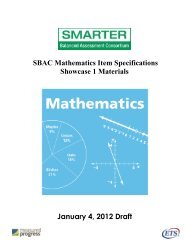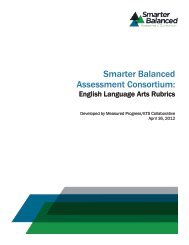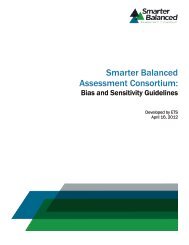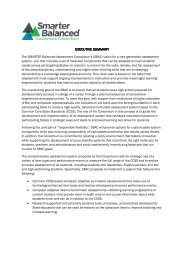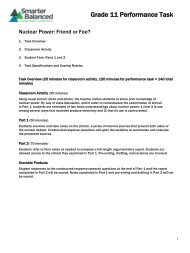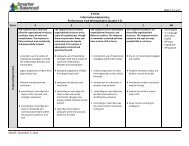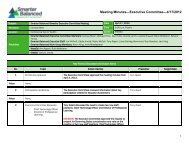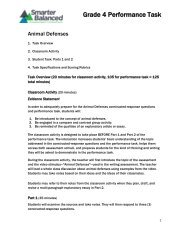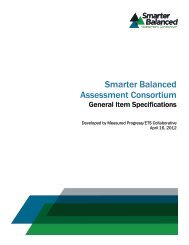Content Specifications for the Summative Assessment of the ...
Content Specifications for the Summative Assessment of the ...
Content Specifications for the Summative Assessment of the ...
You also want an ePaper? Increase the reach of your titles
YUMPU automatically turns print PDFs into web optimized ePapers that Google loves.
including distinguishing connotationdenotation<br />
and words with multiple meanings<br />
(academic/tier 2 words), based on context,<br />
word patterns, word relationships, etymology,<br />
or use <strong>of</strong> specialized resources (e.g.,<br />
dictionary, <strong>the</strong>saurus, digital tools)<br />
Standards: RL-4; L-4, L-5b, L-6<br />
(DOK 1, DOK 2)<br />
4. REASONING & EVALUATION: Apply<br />
reasoning and a range <strong>of</strong> textual evidence to<br />
justify inferences or judgments made<br />
(development <strong>of</strong> universal <strong>the</strong>mes, characters;<br />
impact <strong>of</strong> point <strong>of</strong> view or discourse style<br />
(e.g., dramatic irony, humor, satire,<br />
understatement) on plot/subplot development)<br />
Standards: RL-2, RL-3, RL-6<br />
(DOK 3)<br />
choices on meaning and tone, including words with multiple meanings or language that is<br />
particularly fresh, engaging, or beautiful.<br />
L-4 Determine or clarify <strong>the</strong> meaning <strong>of</strong> unknown and multiple‐meaning words and<br />
phrases, choosing flexibly from a range <strong>of</strong> strategies.<br />
a. Use context (e.g., <strong>the</strong> overall meaning <strong>of</strong> a sentence, paragraph, or text; a word’s<br />
position or function in a sentence) as a clue to <strong>the</strong> meaning <strong>of</strong> a word or phrase.<br />
b. Identify and correctly use patterns <strong>of</strong> word changes that indicate different meanings or<br />
parts <strong>of</strong> speech (e.g., conceive, conception, conceivable).<br />
c. Consult general and specialized reference materials (e.g., dictionaries, glossaries,<br />
<strong>the</strong>sauruses), both print and digital, to find <strong>the</strong> pronunciation <strong>of</strong> a word or determine or<br />
clarify its precise meaning, its part <strong>of</strong> speech, its etymology, or its standard usage.<br />
d. Verify <strong>the</strong> preliminary determination <strong>of</strong> <strong>the</strong> meaning <strong>of</strong> a word or phrase (e.g., by<br />
checking <strong>the</strong> inferred meaning in context or in a dictionary).<br />
L-5b Demonstrate understanding <strong>of</strong> figurative language, word relationships, and<br />
nuances in word meanings.<br />
b. Analyze nuances in <strong>the</strong> meaning <strong>of</strong> words with similar denotations.<br />
L-6 Acquire and use accurately general academic and domain-specific words and<br />
phrases, sufficient <strong>for</strong> reading, writing, speaking, and listening at <strong>the</strong> college and career<br />
readiness level; demonstrate independence in ga<strong>the</strong>ring vocabulary knowledge when<br />
considering a word or phrase important to comprehension or expression.<br />
RL-2 Determine two or more <strong>the</strong>mes or central ideas <strong>of</strong> a text and analyze <strong>the</strong>ir<br />
development over <strong>the</strong> course <strong>of</strong> <strong>the</strong> text, including how <strong>the</strong>y interact and build on one<br />
ano<strong>the</strong>r to produce a complex account; provide an objective summary <strong>of</strong> <strong>the</strong> text.<br />
RL-3 Analyze <strong>the</strong> impact <strong>of</strong> <strong>the</strong> author’s choices regarding how to develop and relate<br />
elements <strong>of</strong> a story or drama (e.g., where a story is set, how <strong>the</strong> action is ordered, how <strong>the</strong><br />
characters are introduced and developed).<br />
RL-6 Analyze a case in which grasping point <strong>of</strong> view requires distinguishing what is<br />
directly stated in a text from what is really meant (e.g., satire, sarcasm, irony, or<br />
understatement).<br />
Use <strong>the</strong> specific text (or two or more texts) to determine two additional assessment targets (#5, #6, or #7) to be<br />
assessed in relation to <strong>the</strong> text(s).<br />
5. ANALYSIS WITHIN OR ACROSS RL-3 Analyze <strong>the</strong> impact <strong>of</strong> <strong>the</strong> author’s choices regarding how to develop and relate<br />
TEXTS: Analyze interrelationships among elements <strong>of</strong> a story or drama (e.g., where a story is set, how <strong>the</strong> action is ordered, how <strong>the</strong><br />
literary elements within a text, or how<br />
characters are introduced and developed).<br />
different texts address topics, <strong>the</strong>mes, or use <strong>of</strong> RL-7 Analyze multiple interpretations <strong>of</strong> a story, drama, or poem (e.g., recorded or live<br />
source material<br />
production <strong>of</strong> a play or recorded novel or poetry), evaluating how each version interprets<br />
Standards: RL-3, RL-7, RL-9<br />
<strong>the</strong> source text.<br />
(DOK 3, 4)<br />
RL-9 Demonstrate knowledge <strong>of</strong> eighteenth‐, nineteenth‐ and early‐twentieth‐century<br />
foundational works <strong>of</strong> American literature, including how two or more texts from <strong>the</strong><br />
same period treat similar <strong>the</strong>mes or topics.<br />
6. TEXT STRUCTURES/FEATURES:<br />
Analyze text structures, genre-specific<br />
features, or <strong>for</strong>mats (visual/graphic/auditory<br />
effects) <strong>of</strong> texts and <strong>the</strong> impact <strong>of</strong> those<br />
choices on meaning or presentation<br />
Standards: RL-5, RL-7<br />
(DOK 3, DOK 4)<br />
7. LANGUAGE USE: Determine or analyze<br />
<strong>the</strong> figurative (e.g., euphemism, oxymoron,<br />
hyperbole, paradox), or connotative meanings<br />
<strong>of</strong> words and phrases used in context and <strong>the</strong><br />
impact <strong>of</strong> those word choices on meaning and<br />
tone<br />
Standards: RL-4; L-5a (gr 9-10), L-5a (gr<br />
11-12)<br />
(DOK 3)<br />
RL-5 Analyze how an author’s choices concerning how to structure specific parts <strong>of</strong><br />
a text (e.g., <strong>the</strong> choice <strong>of</strong> where to begin or end a story, <strong>the</strong> choice to provide a comedic or<br />
tragic resolution) contribute to its overall structure and meaning as well as its aes<strong>the</strong>tic<br />
impact.<br />
RL-7 Analyze multiple interpretations <strong>of</strong> a story, drama, or poem (e.g., recorded or live<br />
production <strong>of</strong> a play or recorded novel or poetry), evaluating how each version interprets<br />
<strong>the</strong> source text. (Include at least one play by Shakespeare and one play by an American<br />
dramatist.)<br />
RL-4 Determine <strong>the</strong> meaning <strong>of</strong> words and phrases as <strong>the</strong>y are used in <strong>the</strong> text, including<br />
figurative and connotative meanings; analyze <strong>the</strong> impact <strong>of</strong> specific word choices on meaning and<br />
tone, including words with multiple meanings or language that is particularly fresh, engaging, or<br />
beautiful.<br />
L-5a (gr 9-10) Interpret figures <strong>of</strong> speech (e.g., euphemism, oxymoron) in context and<br />
analyze <strong>the</strong>ir role in <strong>the</strong> text.<br />
L-5a (gr 11-12) Interpret figures <strong>of</strong> speech (e.g., hyperbole, paradox) in context and<br />
analyze <strong>the</strong>ir role in <strong>the</strong> text.<br />
Grade 11 SUMMATIVE ASSESSMENT TARGETS<br />
ELA/Literacy Claim #1- In<strong>for</strong>mational Texts<br />
Students can read closely and analytically to comprehend a range <strong>of</strong> increasingly complex<br />
literary and in<strong>for</strong>mational texts.<br />
38



